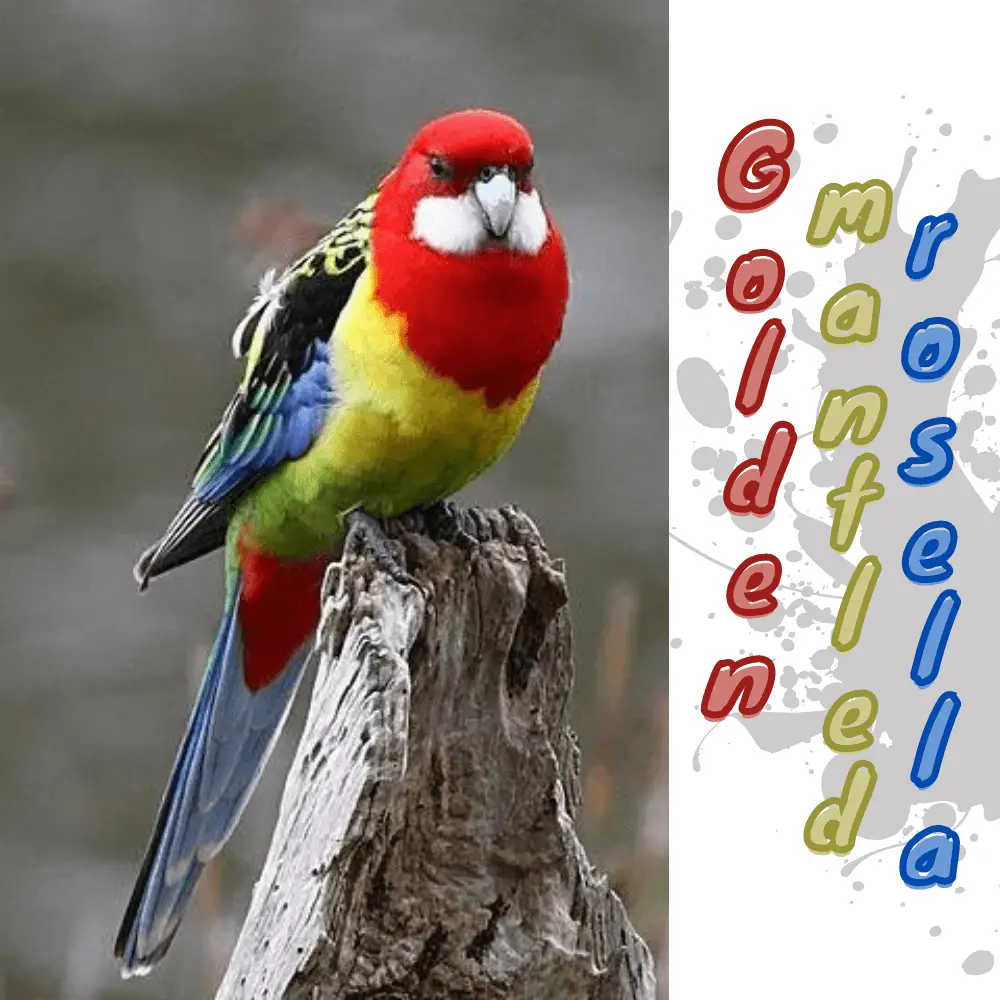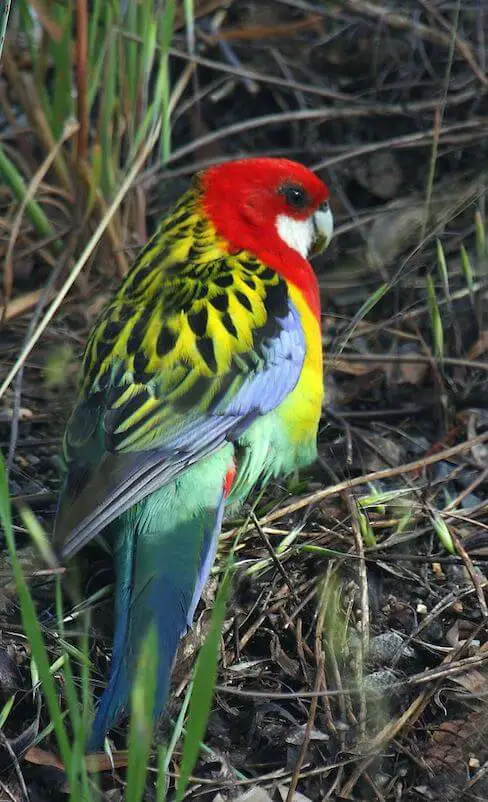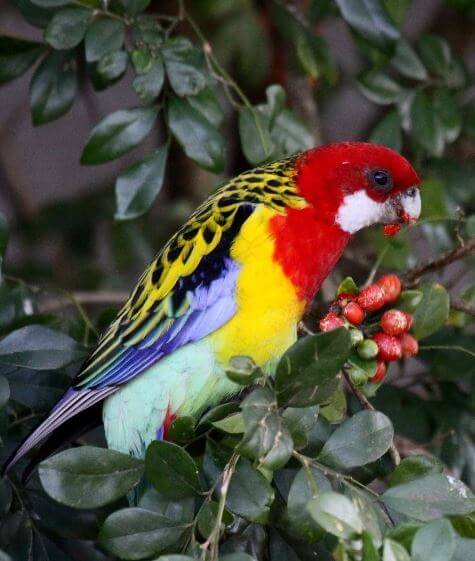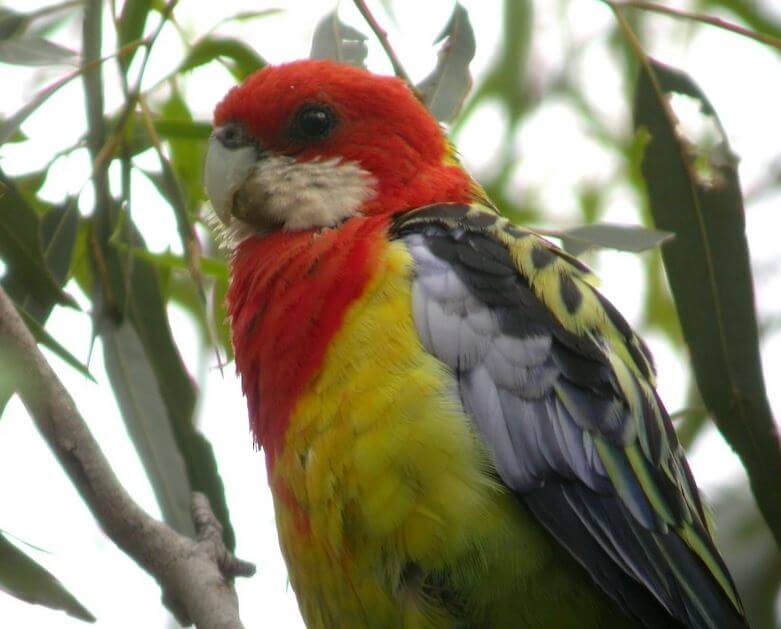
Golden-mantled rosella or Eastern Rosella 30 cm; 90–120 g. Bill whitish, with white lower cheeks and chin; rest of head and breast red, upper belly yellow, lower belly pale green, under tail-coverts red; mantle, back, and scapulars black-edged yellow, creating scaled effect;
median wing-coverts black, lesser wing-coverts, outer secondary coverts, and flight-feathers edged grey-blue; tail bottle green centrally, with outer feathers blue-grey tipped white. The Golden-mantled rosella Female has a duller red head and pale underwing stripe.
Immature like a female with green on to the back of the head. Race Cecilie has darker redhead, richer yellow on the back, blue-green rump; diagenesis has larger cheek patches, darker redhead.
Editor’s Note: This article requires further editing work to merge existing content into the appropriate Subspecies sections. Please bear with us while this update takes place.
Forms a species group with P. venustus and P. ascites, and is sometimes considered conspecific with both. N population formerly recognized sub specifically as Cecilia, but the description of that regarded as unidentifiable. The name aureodorsalis is a junior synonym of electrical. Three subspecies were recognized.
Subspecies
Introduced (probably nominate race) to New Zealand.
Platycercus eximius elecica Scientific name definitions
Distribution
Platycercus eximius Eximius Scientific name definitions
Distribution
Platycercus eximius diemenensis Scientific name definitions
Distribution
Distribution
Editor’s Note: Additional distribution information for this taxon can be found in the ‘Subspecies’ article above. In the future, we will develop a range-wide distribution article.

Habitat
Movement
Sedentary.
Diet and Foraging

A wide range of plant species was used, with 82 recorded in one study. Golden-mantled rosella Seeds of Eucalyptus and Acacia are particularly favored, with seeds of many shrubs and grasses also taken, e.g. Capsella bursapastoris,
Cerastium vulgatum, Melilotus alba, Onopordon acanthium, Carduus marionus, Hypochaeris radicata, Actinotus helianthi, Amaranthus, and Oxalis; sometimes extract seeds from dung. Other food recorded includes berries of Pyracantha and Crataegus, eucalypt blossoms,
Populus leaf-buds, Gazania leaves, insects and their eggs and larvae, Schedotrioza psyllids (animal material notably in Jul); commonly takes spilled grain in farmyards and at roadsides, and can be a pest in orchards.
SOURCE: Tony Palmer
Sounds and Vocal Behavior
Flight call is a loud emphatic “keet!” or “chee-cheet!”, repeated in loose series. When perched utters rather melodious squabbling phrases and a series of repeated pure whistles such as a very fast “beebeebeebeep!” or a descending “pee-pee-pee-pee-peu-peu”.
Breeding

Aug–Feb, occasionally Apr–May. Golden-mantled Rosella Nest in a hollow limb or hole in a tree, generally a eucalypt, or in the stump, fence post, fallen log, rabbit burrow, enlarged tunnel of Rainbow Bee-eater (Merops ornatus),
a disused hole of Laughing Kookaburra (Dacelo novaeguineae) in an arboreal termitarium, elkhorn fern on side of the house, rock face, buildings and even a deserted nest of a babbler (Pomatostomus).
In New Zealand, 66·7% of nests are in Vitex lucens trees and 28·6% in dead tree ferns (Cyathea); nest holes at 3–12 m above the ground. Eggs 4–9, usually 5; incubation lasts 19 days; nestling Chicks at nest period c. 35 days.
Rosellas as Pets
SOURCE: Love of Pets
Conservation Status

Not globally threatened. CITES II. Extremely common in most of the range, but only locally numerous in Tasmania. Has benefited from clearance of forested areas for pasture and cereal cultivation.




















